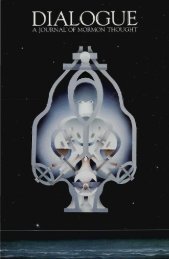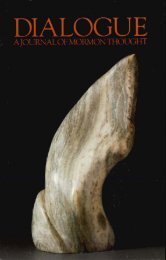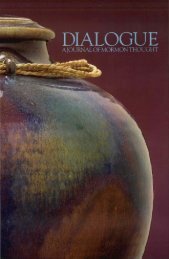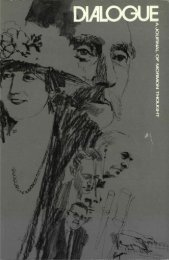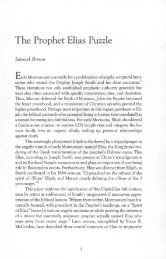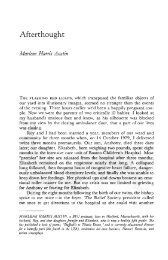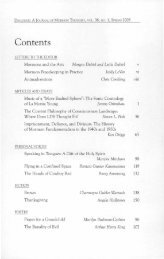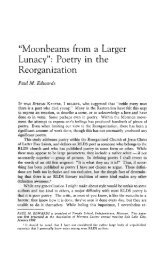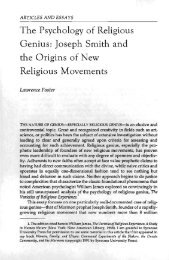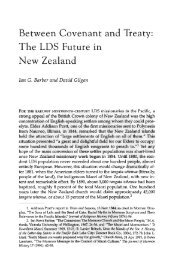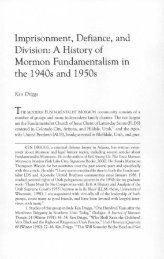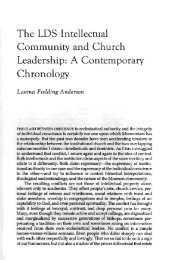Dialogue, Volume 25, Number 2 - Dialogue – A Journal of Mormon ...
Dialogue, Volume 25, Number 2 - Dialogue – A Journal of Mormon ...
Dialogue, Volume 25, Number 2 - Dialogue – A Journal of Mormon ...
You also want an ePaper? Increase the reach of your titles
YUMPU automatically turns print PDFs into web optimized ePapers that Google loves.
28 DIALOGUE: A JOURNAL OF MORMON THOUGHT<br />
<strong>of</strong> his family and friends decided to leave the Church and the community<br />
at Springville. They were murdered under suspicious circumstances,<br />
and although the perpetrators were never found, a number <strong>of</strong><br />
commentators associated the deeds with the doctrine <strong>of</strong> blood atonement<br />
(Furniss 1960, 88-89; CHC 4:176n).<br />
Clearly, Church leaders promoted spiritual reform hoping to restore<br />
the spirituality that the Saints had enjoyed during the hardships <strong>of</strong><br />
Kirtland, Missouri, Nauvoo, and during the exodus and the early settlement<br />
in Utah. After preaching reformation in Bountiful and other<br />
Davis County settlements, Church leaders recognized that they would<br />
have to goad others into accepting their point <strong>of</strong> view. They began to<br />
work the Reformation among their own number. At the October 1856<br />
general conference, they dedicated a new baptismal font on the east<br />
side <strong>of</strong> the Endowment House on Temple Square. As an example <strong>of</strong><br />
the recommitment demanded <strong>of</strong> Church members, President Young<br />
rebaptized his two counselors along with Wilford Woodruff, Lorenzo<br />
Snow, and Franklin D. Richards, the only members <strong>of</strong> the Twelve not<br />
out establishing settlements or supervising proselyting work. In the<br />
days afterward, Church leaders called others to accept rebaptism<br />
(Woodruff 1983-85, 4:458-61).<br />
October conference continued for several days, and the calls for<br />
reformation became increasingly intense and personal. In a severe and<br />
pointed attack on 7 October, Grant, Woodruff, and a number <strong>of</strong> the<br />
other authorities met in the Old Salt Lake Tabernacle with the seventies<br />
quorums. Joseph Young, senior president <strong>of</strong> the First Council <strong>of</strong><br />
the Seventy, who had helped Grant inaugurate the Reformation in<br />
Davis County, conducted the meeting, calling for contributions to sustain<br />
the missionary work. Few <strong>of</strong>fered to donate money. Grant then<br />
rose to speak and said he would not recommend that they call the<br />
presidents <strong>of</strong> seventies to preach, since, he said, "they would Preach<br />
the people to sleep & then to Hell." Calling several <strong>of</strong> the presidents<br />
including Henry Harriman, Albert P. Rockwood, Zera Pulsipher,<br />
Benjamin Clapp, and Horace S. Eldridge by name, he accused them<br />
<strong>of</strong> committing adultery or some other serious sin <strong>of</strong> commission or<br />
omission, and he urged Young to "cut them <strong>of</strong>f & prune the trees<br />
around him" (Woodruff 1983-85, 4:468). Several <strong>of</strong> the presidents<br />
spoke up to defend themselves and deny the charges. Woodruff then<br />
took the pulpit to reinforce Grant's accusations, announcing that he<br />
"would like to bear testimony to what [Grant] . . . had said." He then<br />
"said to the people that I wished them not to trifle with the teachings<br />
<strong>of</strong> President Grant for what He has said was true." Woodruff urged<br />
them to repent and to "get the spirit <strong>of</strong> God" (Woodruff 1983-85,<br />
4:469).



